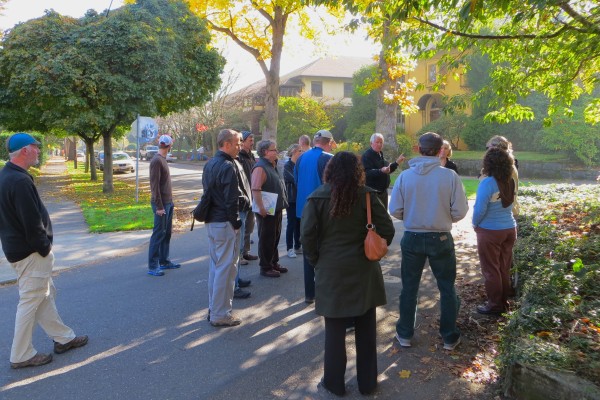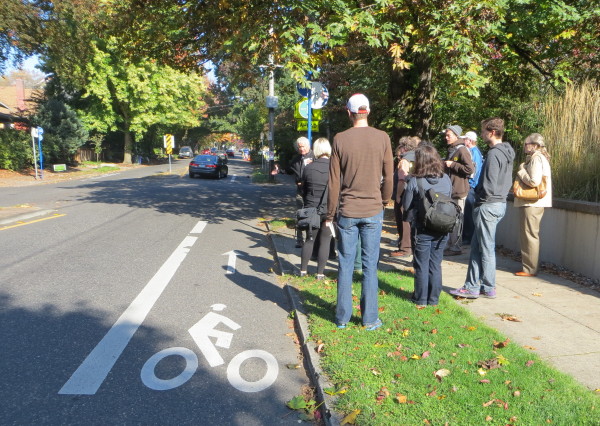Autumn weekends are generally reserved for admiring the changing colors, but at about 9:30 AM this past Saturday, a band of over 15 students climbed into a tour bus to behold the wonders of local Portland traffic calming projects.

For 23 years running, the City of Portland and Portland State University have partnered to offer the 10-week Traffic and Transportation Class free of charge to Portland residents. Developed by Congressman Earl Blumenauer and former Metro Executive Officer Rick Gustafson (who has taught the class since its inception), the class was designed to equip neighborhood activists with the knowledge of how their local transportation systems and agencies work – and more importantly, how to work with them to implement community projects. Weekly guest speakers are generally the top dogs of their office (PBOT Director Leah Treat spoke last week) and they present to students about the history, goals, and current issues of their department.

The field trip is a highlight of the course, when Rick takes the class on a tour of community-led projects throughout Portland to demonstrate how concerned neighbors have successfully worked with the City to solve problems, experiment with new strategies, and in some cases, change the rules entirely. At NE 16th & Tillamook, the class de-boarded to check out a landscaped traffic diverter that was originally a guerilla installation poured in concrete overnight by neighbors concerned with speeders using their street as a cut-through. At NE 15th & Thompson, Rick explained the 10 foot long bike lane oddities – part of a traffic calming device called slow points that visually narrows the street for drivers and creates safer crossings for pedestrians, once illegal under city policy.
Throughout the tour, Rick emphasizes a few key points to the activists-in-training: First, that the City is willing to try out suggestions from the public, but it wants to do projects that are well-accepted and well understood by the neighborhood. The best way for an advocate to get City support on an idea is to get local consensus.

Second, when asking someone at the City to approve or implement a project for you, treat them as a partner rather than an adversary. Understand the constraints they work with, the terminology that they use, and show them how your project can support their agency’s goals, too.
And finally, don’t be deterred by rejection. In fact, don’t expect results until you’ve been told “No” three times. Keep working and keep asking so that you can get that all-important third “No” – then you’re good to go.
The class has already sent over 1,000 community advocates and transportation activists out into the world empowered with the know-how to get things done in their neighborhood. Cheers to the Class of 2013 – we’re looking forward to seeing you make your marks.
Have you taken this class? What was your class project and how did it turn out?
7 responses to “23 Years and Counting”
Really a great class with an amazing list of speakers from throughout the Portland transportation scene. Highly recommended for anyone interested in transportation activism in Portland. Check it out!
Essential for anyone wanting to make a difference in the transportation/land use picture in greater Portland. I worked up my pitch to TriMet for a direct bus to Swan Island during the class in 1992 or so. The 85 Swan Island began service in ’95!
I would think the “10 foot” bike lanes at islands would also discourage people from stopping/parking there and preventing wider vehicles from making it through.
I think it was 1998 that I took the class. A great, fun, and empowering class. I recall some classmates that have since taken important positions in our city and beyond – Linda Ginenthal and Phil Goff come to mind.
My project? Buffered bike lanes!
Thanks for the article Rebecca. Check out the City’s website on the class for more information – https://www.portlandoregon.gov/transportation/35727
I wish those bike lanes were still illegal, honestly. I think they are terrible pieces of infrastructure. I’d be interested in a data-oriented rebuttal to that opinion, though.
My project from this class just got finished this summer. Check out the 9200 Block of Ramona Street in person. (Then get a taco if you need a reason to be there).